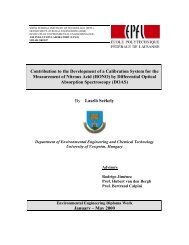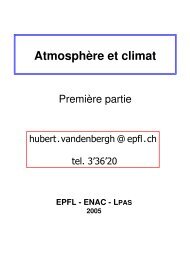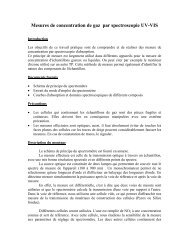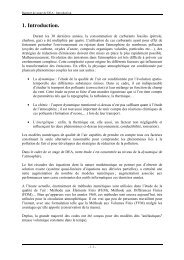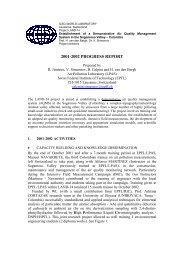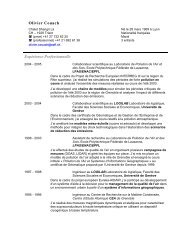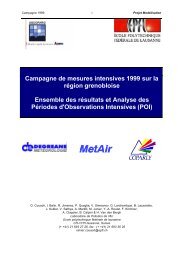Diploma report Implementation and verification of a simple ... - LPAS
Diploma report Implementation and verification of a simple ... - LPAS
Diploma report Implementation and verification of a simple ... - LPAS
Create successful ePaper yourself
Turn your PDF publications into a flip-book with our unique Google optimized e-Paper software.
3.3.4 Richtmeyer Two-Step Lax-Wendr<strong>of</strong>f Method<br />
The Richtmeyer Two-Step Lax-Wendr<strong>of</strong>f method is <strong>of</strong> second order. This is achieved by using<br />
a better approximation to the average flux (27). In this method a half step in time is first<br />
made using the Lax-Friedrichs method at the cell interfaces (∆x, ∆z <strong>and</strong> ∆t are replaced<br />
by 1/2∆x, 1/2∆z <strong>and</strong> 1/2∆t). The numerical approximation <strong>of</strong> q at the midpoint in time<br />
t n+1/2 = t n + 1 2∆t is given by<br />
<strong>and</strong> the flux is evaluated at this point<br />
Q n+1/2<br />
i−1/2j = 1 2 (Qn i−1j + Q n ij) − ∆t<br />
2∆x [f(Qn ij) − f(Q n i−1j)], (37)<br />
F n<br />
i−1/2,j = f(Qn+1/2 i−1/2j ) (38)<br />
Although more accurate than the Lax-Friedrichs method, this method <strong>of</strong>ten leads to oscillations<br />
in solutions.<br />
3.4 Time integration<br />
In section 3.1, a system <strong>of</strong> ordinary differential equations (23) for the evolution <strong>of</strong> cell averages<br />
Q ij (t) in time was derived. Our model solves the partial differential equation (16) that<br />
contains source <strong>and</strong> correction terms in addition to the flux terms. This is done using a<br />
splitting technique, first solving<br />
<strong>and</strong> then making the post update<br />
q t + ˜f(q) x + ˜g(q) z = s(q), (39)<br />
q t = r(q). (40)<br />
The flux terms in (39) are tilded as, in addition to the regular fluxes, they contain the flux<br />
correction terms due to the potential energy.<br />
Performing a finite volume discretization for (39) yields the following system <strong>of</strong> ODEs<br />
dQ<br />
dt = RHS x(Q) + RHS z (Q) + S(Q), (41)<br />
where RHS x (Q) <strong>and</strong> RHS z (Q) consist in the x- <strong>and</strong> z-flux terms <strong>and</strong> S(Q) is the source term.<br />
For simplicity, these three terms can be replaced by F(Q) giving<br />
dQ<br />
dt<br />
= F(Q). (42)<br />
The discretization in time can then be done by using any st<strong>and</strong>ard method for systems <strong>of</strong><br />
ODEs. Some time-discretization methods will be presented in this section.<br />
14



